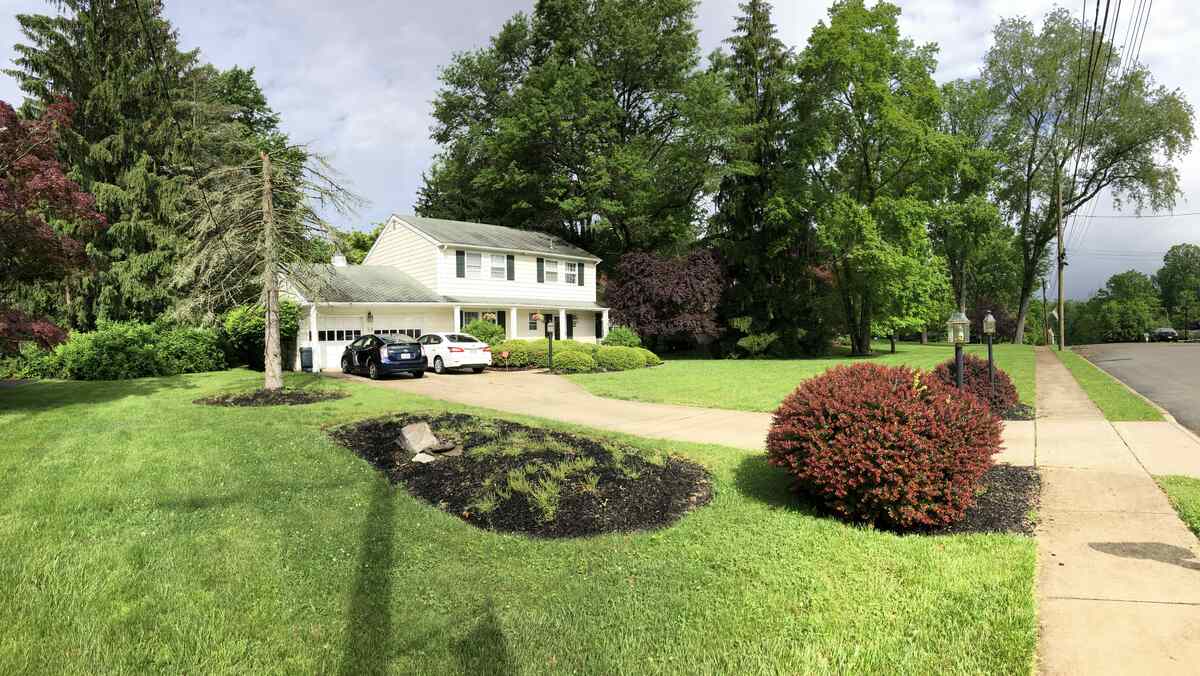
If you’re an Easterner and live in the Garden State, you know we have crazy weather extremes. One day, it will be 80 degrees and balmy; the next, it will be 32 degrees and snowing. New Jersey lawns also take the brunt of these unpredictable weather conditions, so homeowners should know the best grass seed for New Jersey.
We’ve included an overview at the end if you’re looking for a short guide on choosing the best grass seed for New Jersey.
New Jersey Climate
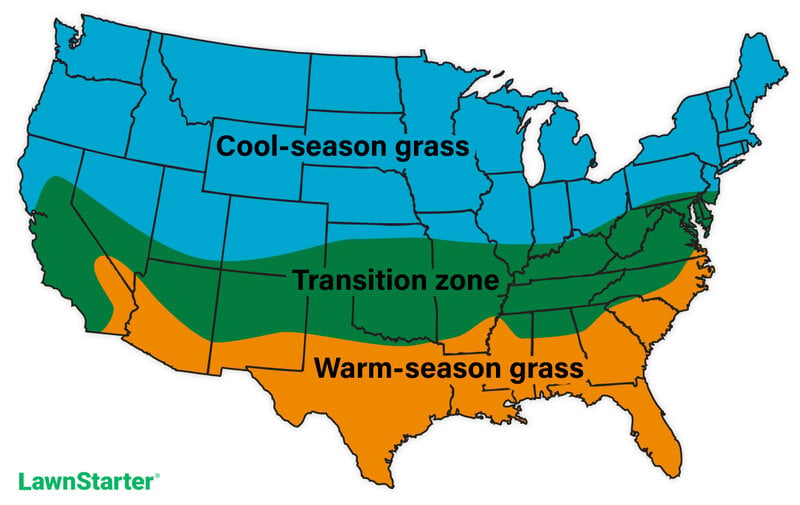
New Jersey is located in the northeastern region of the United States. Some consider the state’s southern portion to be in the transition zone. This zone is tricky for growing grass successfully — warm-season grasses that thrive in the South hate the cold winters, and cool-season grasses that love the cold weather of the North don’t like the hot summers.
Cool-Season Grasses
Fine Fescue
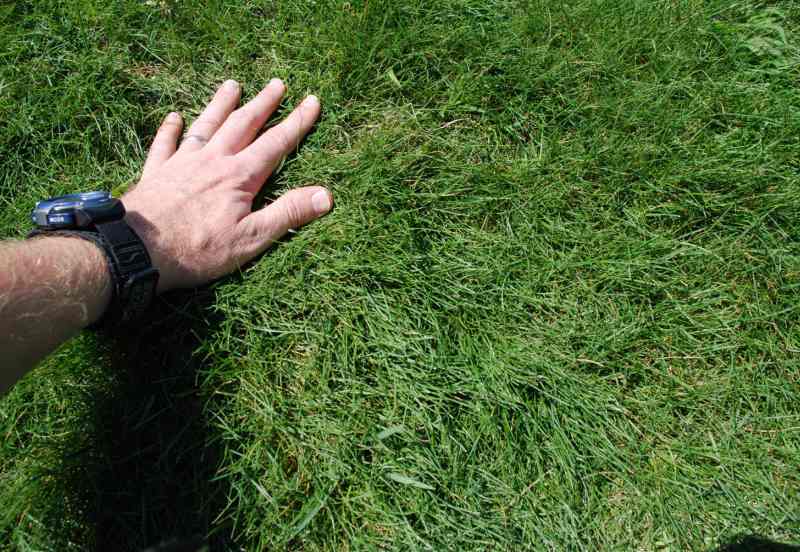
Aaron J. Patton, Ph.D. / Turfgrass Extension Specialist at Purdue University
Fine fescues are a group of cool-season grasses recognized by their thin, needle-like leaves. They are popular for low-maintenance lawns due to their tolerance for drought. Their low fertilizer requirement is a bonus.
Fine fescues are often included in turfgrass seed mixes and are commonly mixed with Kentucky bluegrass in New Jersey. Their ability to thrive in less-than-ideal and shaded conditions makes them a favorite among homeowners.
Classification: Cool-season grass
Spreads by: Creeping red fescue spreads by rhizomes, while other fine fescues are bunch-type grasses, such as Chewings, hard, and sheep fescues.
Shade tolerance: Moderate to High, depending on the species
Drought tolerance: Moderate to High, depending on the species
Foot traffic tolerance: Low to Moderate, depending on the species
Maintenance needs: Low fertilizer and mowing needs
Mowing height: Set the mowing size between 2.5 and 4 inches, depending on the species.
Potential for disease: Moderate. Common diseases include red thread, leaf spot, dollar spot, summer patch, and powdery mildew.
Soil pH: 6-6.5
Soil type: Will perform poorly in wet soil conditions. Prefers drier soils and tolerates a wide range of soil types and fertility.
Other notes: Sharpen your mower blade often for the best cut.
Grass Seed Options:
– Outsidepride Legacy Fine Fescue Grass Seed (5 lbs.)
– Eretz Creeping Red Fine Fescue Seed (choose your size)
– Outsidepride Creeping Red Fine Fescue Grass Seed (25 lbs.)
– Outsidepride Hard Fine Fescue Grass Seed (10 lbs.)
Kentucky Bluegrass

Photo Credit: Shutterstock
Kentucky bluegrass is a cool-season grass popular in lawns across the northern United States due to its ability to thrive in cooler temperatures. It is often mixed with fine fescue for optimal growth and shade tolerance in lawns with partial shade. Kentucky bluegrass should be seeded in early spring or early to mid-fall to avoid the quickly approaching cold weather of late fall.
Classification: Cool-season grass
Spreads by: Rhizomes
Shade tolerance: Low
Drought tolerance: Moderate
Foot traffic tolerance: Moderate
Maintenance needs Moderate mowing frequency and high fertilization needs.
Mowing height: Set mowing height between 2.5 and 3.5 inches.
Potential for disease: Moderate to high; prone to several diseases, such as dollar spot, leaf spot, necrotic ring spot, summer patch, and stripe smut.
Soil pH: 6-7.5
Soil type: Performs best in well-drained, heavy soils with high fertility.
Other notes: Kentucky bluegrass develops thatch, but aeration and dethatching will help reduce this.
Grass Seed Options:
– Jonathan Green (11970) Blue Panther Kentucky Bluegrass Grass Seed (3 lbs.)
– SeedRanch Midnight Kentucky Bluegrass Seed (5 lbs.)
Perennial Ryegrass
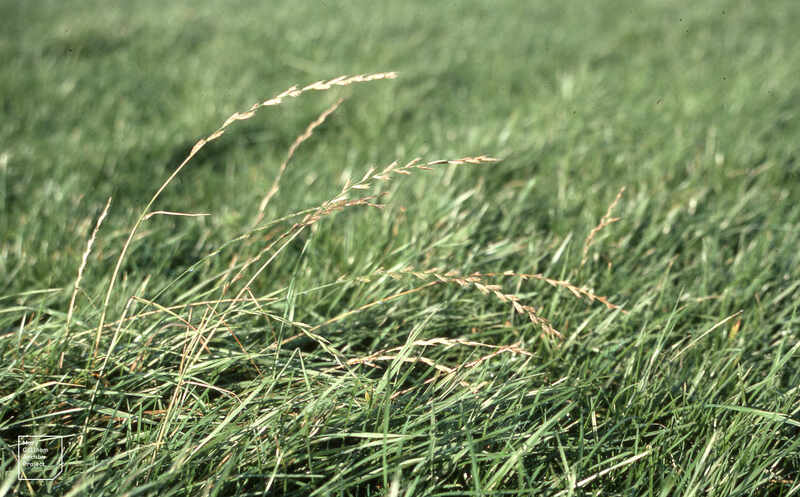
Photo Credit: Dr Mary Gillham Archive Project / Flickr / CC BY 2.0
Perennial ryegrass is a popular choice for pastures and lawns in New Jersey due to its resilience in cold weather. This grass type is also known for its speedy germination, typically sprouting within one week of planting.
Its fine blades create a lush carpet that can withstand heavy foot traffic as a monostand (single grass) or as part of a cool-season mix. Perennial ryegrass can maintain its vibrant green color year-round with proper irrigation during the hottest summer months.
Classification: Cool-season grass
Spreads by: Has a bunch-type growth habit
Shade tolerance: Low
Drought tolerance: Low
Foot traffic tolerance: High
Maintenance needs: Moderate mowing and fertilization requirements. Thatch is not significant.
Mowing height: Set mowing height to 1.5 to 2.5 inches
Potential for disease: High. Common diseases include gray leaf spot, red thread, and leaf spot/melting-out.
Soil pH: Can grow in soils with a pH between 5 and 8 but prefers between 6 and 7.
Soil type: Prefers good drainage and fertility but can tolerate some poor drainage.
Other notes: A common strategy to revive worn-out turf is by overseeding annually with perennial ryegrass in late August and September.
Grass Seed Options:
– Outsidepride Perennial Ryegrass Seed (5 lbs.)
– Eretz ProTurf Perennial Ryegrass Fine Lawn Seed (choose your size)
Tall Fescue

Aaron J. Patton, Ph.D. / Turfgrass Extension Specialist at Purdue University
Tall fescue is a cool-season grass that thrives in cool and humid regions. However, it is not tolerant of hot summer temperatures. Having said that, tall fescue can withstand drought conditions, disease, and moderate foot traffic from walking and playing.
Overseeding tall fescue in the spring or fall can give your lawn a much-needed boost and help it recover from the damage after hot and dry summers.
Classification: Cool-season grass
Spreads by: Produces short rhizomes but has a bunch-type growth habit
Shade tolerance: Moderate
Drought tolerance: Moderate to High
Foot traffic tolerance: Moderate
Maintenance needs: Frequent mowing. Does not produce significant thatch.
Mowing height: Set mowing height to 2 inches when the grass reaches 3 inches tall.
Potential for disease: Tolerant of most diseases when properly maintained.
Soil pH: 5.5-6.5
Soil type: Adapted to a wide range of soil conditions but prefers fertile clay soils with good drainage.
Other notes: Tall fescue is often mixed with 5-15% Kentucky bluegrass for high-traffic areas.
Grass Seed Options:
– Triple-Play Tall Fescue Grass Seed Blend (5000 sq ft)
– Eretz Kentucky 31 K31 Tall Fescue Grass Seed (choose your size)
– Pennington The Rebels Tall Fescue Grass Seed Mix (7 lb.)
Warm-Season Grass
Zoysiagrass
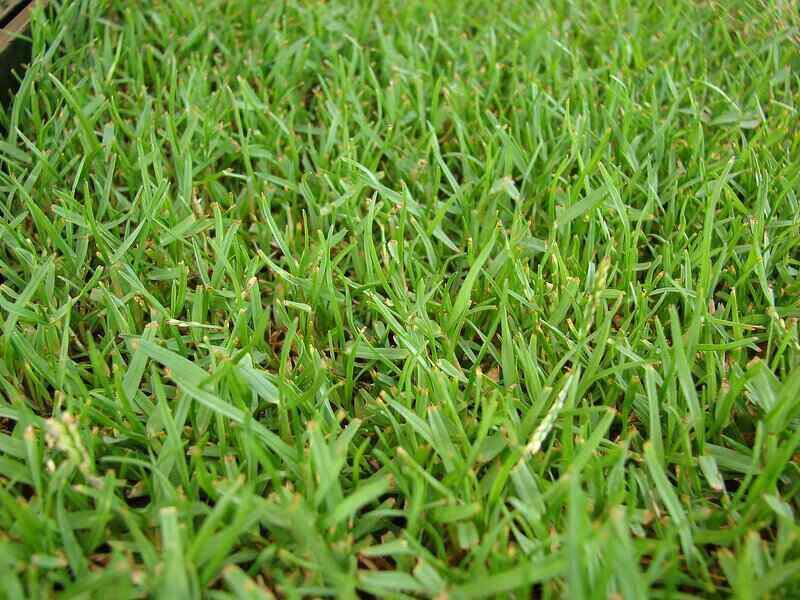
Photo Credit: Forest & Kim Starr / Wikimedia Commons / CC BY 3.0 US
Zoysiagrass, the only warm-season grass on our list, is well-suited for the transition zone. Homeowners favor this grass for its ability to withstand drought, heavy foot traffic, and thrive in the sandy soils found in southern New Jersey. It can also tolerate shade and requires minimal maintenance (low nitrogen fertilization), making it a popular choice for low-maintenance lawns.
Tip: In New Jersey, it is possible to overseed Zoysiagrass with perennial ryegrass in mid-September to provide a green winter color in your lawn. Since the ryegrass will establish quickly, it will provide a green lawn during the fall and early spring since Zoysia is dormant and brown from mid-October until mid-May.
Classification: Warm-season grass
Spreads by: Stolons and rhizomes
Shade tolerance: Moderate
Drought tolerance: Moderate to High
Foot traffic tolerance: High, but recovers slowly from damage
Maintenance needs: Low nitrogen fertilization requirements, although it’s prone to thatch build-up.
Mowing height: Set mowing height between 1 and 2 inches.
Potential for disease: Good disease tolerance overall
Soil pH: 6-6.5
Soil type: Well-draining, some cultivars are more tolerant of a wide range of soils than others.
Other notes: From June through September, watch for insect damage from chinch bugs, bill bugs, and sod webworms in your Zoysia lawn. Using insecticides such as diazon or dursban is suggested to control and eliminate insect activity effectively.
Grass Plug and Seed Options:
– Zoysia Plugs (50 Large Grass Plugs)
– Zoysia Plugs (50 Full & Lush Grass Plugs)
– Zoysia Plugs (100 Plugs)
– Zenith Zoysia Grass Seeds (1/8 lb. of seeds)
How To Choose The Best Grass Seed For Your New Jersey Lawn
Shade Tolerance
Shade-tolerant turfgrass is best suited for partial or full-shade areas, like under large tree canopies that filter out most of the sun or the north side of buildings.
Low shade tolerance: Kentucky bluegrass, Perennial ryegrass
Moderate shade tolerance: Tall fescue, Zoysiagrass
High shade tolerance: Fine fescue
Drought Tolerance
Give yourself a break and put down that hose! These drought-tolerant grasses are more forgiving when it comes to watering than other grasses. So, relish the joy of sleeping late and not watering at the crack of dawn.
Low drought tolerance: Perennial ryegrass
Moderate drought tolerance: Kentucky bluegrass, Tall fescue, Zoysiagrass
High drought tolerance: Fine fescue
Foot Traffic Tolerance
Is your lifestyle full of social activities — kids playing outside, dogs running around, the neighbors coming over for barbeques? Then, the list of grasses below will help you solve the problem of choosing a grass to thrive in a high-traffic yard.
Low traffic tolerance: Fine fescue
Moderate traffic tolerance: Kentucky bluegrass, Tall fescue
High traffic tolerance: Perennial ryegrass, Zoysiagrass
Maintenance Needs
It’s cool if you are a “turf junkie” and devote every waking minute to your lawn. But if you are like the rest of us who don’t want to be slaves to lawn care and lawn maintenance, opt for these grasses that fit the “lower maintenance” bill.
Low maintenance needs: Fine fescue
Moderate maintenance needs: Perennial ryegrass, Tall fescue, Zoysiagrass (mowing frequency is low)
High maintenance needs: Kentucky bluegrass
Consult the Pros
Looking for a New Jersey lawn care pro near you? We have trusted lawn care pros in Elizabeth, Newark, Camden, Lakewood, and many more cities across the Garden State. They can help you mow, landscape, establish a new lawn, or revitalize it.
Additional source:
Main Image Credit: Famartin / Wikimedia Commons / CC BY-SA 4.0
LawnStarter participates in the Amazon Services LLC Associates Program, an affiliate advertising program. LawnStarter may earn revenue from products promoted in this article.